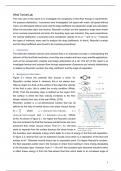Essay
ES2C5 - 1st - Wind Tunnel Lab Report - University of Warwick
- Course
- Institution
Lab Report for the Dynamics and Fluid Mechanics Module (ES2C5) as part of the Engineering Course at the University of Warwick which received a 1st (73%).
[Show more]



